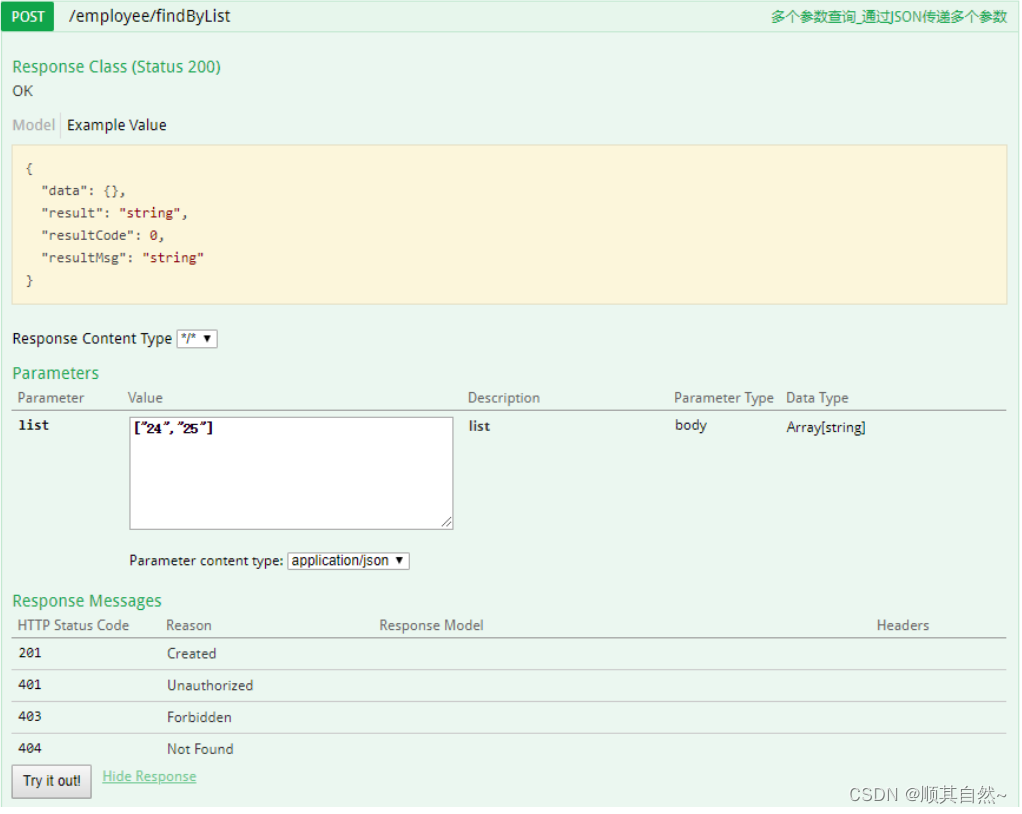在实际开发过程中,增删改查操作都要涉及到请求参数的传递,今天这节就集中讲下在mybatis中传递参数的7中方法
单个参数的传递很简单没有什么好将的,这里主要说下多个参数的传递
1、第一种方式 匿名参数 顺序传递参数
controller
@ApiOperation(value = "多个参数查询_匿名顺序传参")
@GetMapping("findByParams")
public ResultMsg findByParams(Short gender,String age)
{
List result= employeeMapper.selectByGenderAndAge(gender,age);
return ResultMsg.getMsg(result);
}mapper
List<Employee> selectByGenderAndAge(Short gender,String age );xml
<select id="selectByGenderAndAge" resultMap="BaseResultMap" >
select * from employee where gender = #{gender} and age = #{age}
</select>注意这里按参数名去引用的话会报如下错误,mybatis错误提示很细致,这里明确给我们提示,匿名参数只能使用
arg1, arg0, param1, param2 类似的形式
这种传参方式的缺点是不够灵活,必须严格按照参数顺序来引用
BindingException: Parameter 'gender' not found. Available parameters are [arg1, arg0, param1, param2]
所以正确的引用方式如下:
<select id="selectByGenderAndAge" resultMap="BaseResultMap" >
select * from employee where gender = #{param1} and age = #{param2}
</select>2、第二种方式 使用@Param注解
controller
@ApiOperation(value = "多个参数查询_注解方式传参")
@GetMapping("findByParams2")
public ResultMsg findByParams2(Short gender,String age)
{
List result= employeeMapper.selectByGenderAndAge2(gender,age);
return ResultMsg.getMsg(result);
}mapper
使用@Param注解显示的告诉mybatis参数的名字,这样在xml中就可以按照参数名去引用了
List<Employee> selectByGenderAndAge( @Param("gender") Short gender,@Param("age") String age );xml
<select id="selectByGenderAndAge" resultMap="BaseResultMap" >
select * from employee where gender = #{gender} and age = #{age}
</select>3、使用Map传递参数
实际开发中使用map来传递多个参数是一种推荐的方式
controller
@ApiOperation(value = "多个参数查询")
@GetMapping("findByMapParams")
public ResultMsg findByMapParams(Short gender,String age)
{
Map params = new HashMap<>();
params.put("gender",gender);
params.put("age",age);
List result= employeeMapper.selectByMapParams(params);
return ResultMsg.getMsg(result);
}mapper
List<Employee> selectByMapParams(Map params);可以看到使用map来传递多个参数,可以直接使用参数名称进行引用
<select id="selectByMapParams" resultMap="BaseResultMap" parameterType="map">
select * from employee where gender = #{gender} and age = #{age}
</select>4、用过java bean传递多个参数
也可以使用bean的方式来传递多个参数,使用时parameterType指定为对应的bean类型即可
这就传参方式的优点是比较方便,controller层使用@RequestBody接收到实体类参数后,直接传递给mapper层调用即可,不需要在进行参数的转换
controller
@ApiOperation(value = "多个参数查询_通过Java Bean传递多个参数")
@PostMapping("findByBeans")
public ResultMsg findByBeans(@RequestBody Employee employee)
{
List result= employeeMapper.selectByBeans(employee);
return ResultMsg.getMsg(result);
}mapper
List <Employee> selectByBeans(Employee employee);xml
参数的引用直接使用bean的字段
<select id="selectByBeans" resultMap="BaseResultMap" parameterType="com.wg.demo.po.Employee">
select
*
from employee where gender = #{gender} and age = #{age}
</select>测试一下:

5、直接使用JSON传递参数
这也是推荐的一种传参方式,controller层收到JSON型数据后,直接传递给mapper层进行查询操作,简单 方便
controller
@ApiOperation(value = "多个参数查询_通过JSON传递多个参数")
@PostMapping("findByJSONObject")
public ResultMsg findByJSONObject(@RequestBody JSONObject params)
{
List result= employeeMapper.findByJSONObject(params);
return ResultMsg.getMsg(result);
}mapper
List <Employee> findByJSONObject(JSONObject params);<select id="findByJSONObject" resultMap="BaseResultMap" parameterType="com.alibaba.fastjson.JSONObject">
select
*
from employee where gender = #{gender} and age = #{age}
</select>测试一下:
6、传递集合类型参数List、Set、Array
在一些复杂的查询中(如 sql中的 in操作),传统的参数传递已无法满足需求,这时候就要用到List、Set、Array类型的参数传递,具体使用如下:
controller
@ApiOperation(value = "多个参数查询_通过List、Set、Array传递多个参数")
@PostMapping("findByList")
public ResultMsg findByList(@RequestBody List<String> list)
{
List result= employeeMapper.findByList (list);
return ResultMsg.getMsg(result);
}mapper
List <Employee> findByList(List list);xml
<select id="findByList" resultMap="BaseResultMap" >
SELECT * from employee where age in
<foreach collection="list" open="(" separator="," close=")" item="age">
#{age}
</foreach>
</select>这里foreach表示循环操作,具体的参数含义如下:
foreach元素的属性主要有 item,index,collection,open,separator,close。
item表示集合中每一个元素进行迭代时的别名,
index指定一个名字,用于表示在迭代过程中,每次迭代到的位置,
open表示该语句以什么开始,
separator表示在每次进行迭代之间以什么符号作为分隔符,close表示以什么结束
在使用foreach的时候最关键的也是最容易出错的就是collection属性,该属性是必须指定的,但是在不同情况下,该属性的值是不一样的,主要有一下3种情况:
- 1.如果传入的是单参数且参数类型是一个List的时候,collection属性值为list
- 2.如果传入的是单参数且参数类型是一个array数组的时候,collection的属性值为array
- 3.如果传入的参数是多个的时候,我们就需要把它们封装成一个Map或者Object
测试:

7、参数类型为对象+集合
该类参数与java Bean参数形式类似,只不过更复杂一些,如下面的Department类,除了基本字段还包括一个Employee的列表
bean
@Data
public class Department {
private Long id;
private String deptName;
private String descr;
private Date createTime;
List<Employee> employees;
}controller
@ApiOperation(value = "多个参数查询_对象+集合参数")
@PostMapping("findByDepartment")
public ResultMsg findByDepartment(@RequestBody Department department)
{
List result= employeeMapper.findByDepartment(department);
return ResultMsg.getMsg(result);
}mapper
List <Employee> findByDepartment(@Param("department")Department department);xml
<select id="findByDepartment" resultMap="BaseResultMap" parameterType="com.wg.demo.po.Department">
SELECT * from employee where dept_id =#{department.id} and age in
<foreach collection="department.employees" open="(" separator="," close=")" item="employee">
#{employee.age}
</foreach>
</select>这里foreach 对应Departmen部门中的List employees
请求参数: 查询部门Id=1,并且年龄 等于24和25的员工
{
"createTime": "2019-07-02T10:17:16.756Z",
"deptName": "string",
"descr": "string",
"employees": [
{
"age": "24",
},
{
"age": "25",
}
],
"id": 1
}
结果:
{
"data": [
{
"address": "北新街ndcpc",
"age": "24",
"createTime": 1562062434000,
"deptId": "1",
"gender": 1,
"id": "318397755696631808",
"name": "kls0bx19cy"
},
{
"address": "北新街lavi0",
"age": "25",
"createTime": 1562062436000,
"deptId": "1",
"gender": 1,
"id": "318397755801489408",
"name": "gj9q3ygikh"
}
],
"result": "SUCCESS",
"resultCode": 200,
"resultMsg": ""
}
